
Additional Information
Book Details
Abstract
Computational biology is a rapidly expanding field, and the number and variety of computational methods used for DNA and protein sequence analysis is growing every day. These algorithms are extremely valuable to biotechnology companies and to researchers and teachers in universities.
This book explains the latest computer technology for analyzing DNA, RNA, and protein sequences. Clear and easy to follow, designed specifically for the non-computer scientist, it will help biologists make better choices on which algorithm to use. New techniques and demonstrations are elucidated, as are state-of-the-art problems, and more advanced material on the latest algorithms.
The primary audience for this volume are molecular biologists working either in biotechnology companies or academic research environments, individual researchers and the institutions they work for, and students. Any biologist who relies on computers should want this book.
A secondary audience will be computer scientists developing techniques with applications in biology.
An excellent reference for leading techniques, it will also help introduce computer scientists to the biology problems. This is an outstanding work which will be ideal for the increasing number of scientists moving into computational biology.
...Clear and easy to follow, designed specifically for the non computer scientist, it will help biologists make better choices on which algorithm to use.
Documentation
(...)an impressive selection of papers, all authored by leading bioinformaticians. The volume covers this large multi-disciplinary field of research quite well, from sequence alignment, pattern discovery, gene finding to protein structure.
Trends in Genetics
(A. Lloyd, INCBI, the Irish EMBnet Node)
The editors have decided to choose authors who have contributed effective software to the community. This horse's mouth approach has the advantage of getting really authoritative explanations of the problems and their solutions.(...)significant effort has been made to introduce each topic in general terms before ploughing deeper into the structure, constraints and functions of biological molecules.
Briefings In Bioinformatics, Vol. 1, No. 3
